
Leucopogon juniperinus, commonly known as prickly beard-heath, is a species of flowering plant in the heath family Ericaceae and is endemic to south-eastern continental Australia. It is an erect, densely-branched shrub with oblong to more or less egg-shaped leaves with the narrower end towards the base, and white, tube-shaped flowers arranged singly in upper leaf axils.

Leucopogon obovatus is a species of flowering plant in the heath family Ericaceae and is endemic to the southwest of Western Australia. It is an erect shrub with hairy young branchlets, variably-shaped, simple leaves, and erect clusters of 3 to 15 white, bell-shaped flowers on the ends of branches and in upper leaf axils.
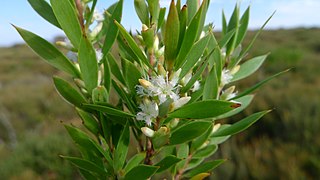
Leucopogon esquamatus, commonly known as the swamp beard-heath, is a species of flowering plant in the heath family Ericaceae and is endemic to south-eastern Australia. It is a slender shrub with mainly elliptic leaves, and short-lived white, tube-shaped flowers arranged singly or in pairs in upper leaf axils.

Leucopogon muticus, commonly knwon as blunt beard-heath, is a species of flowering plant in the heath family Ericaceae and is endemic to eastern Australia. It is an erect, straggling shrub with egg-shaped leaves with the narrower end towards the base, and small numbers of white, tube-shaped flowers that are densely bearded inside.

Leucopogon australis, commonly known as spiked beard-heath, is a species of flowering plant in the heath family Ericaceae and is endemic to southern Australia. It is an erect, aromatic shrub with narrowly egg-shaped to narrowly elliptic leaves, and white flowers arranged in spikes near the ends of branchlets.

Leucopogon clelandii, commonly known as Cleland's bearded-heath, is a species of flowering plant in the heath family Ericaceae and is endemic to the south-east of continental Australia. It is weak, open shrub with broadly egg-shaped leaves and white flowers arranged singly or in pairs in leaf axils near the ends of the branches.

Leucopogon collinus, commonly known as fringed beard-heath, is a species of flowering plant in the heath family Ericaceae and is endemic to south-eastern Australia. It is a slender, erect or spreading shrub with narrowly lance-shaped leaves, and white, tube-shaped, bearded flowers.

Leucopogon costatus, commonly known as twiggy beard-heath, is a species of flowering plant in the heath family Ericaceae and is endemic to southern continental Australia. It is an erect or straggling shrub with broadly egg-shaped, stem-clasping leaves, and white, tube-shaped flowers, the petals densely bearded on the inside.

Leucopogon inflexus is a species of flowering plant in the heath family Ericaceae and is endemic to the south-west of Western Australia. It is an erect, open shrub with more or less glabrous young branchlets, spirally arranged, erect, egg-shaped to more or less round leaves, and white, bell-shaped, densely bearded flowers.
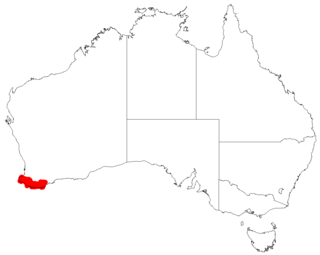
Leucopogon interstans is a species of flowering plant in the heath family Ericaceae and is endemic to the south-west of Western Australia. It is an erect shrub with brownish hairs on its young branchlets, erect, narrowly elliptic or narrowly egg-shaped leaves and white or pinkish flowers in groups in upper leaf axils or on the ends of branches.
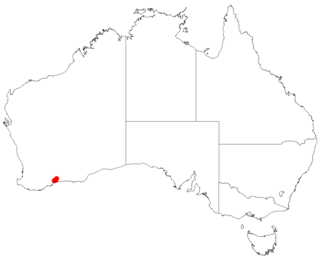
Leucopogon lloydiorum is a species of flowering plant in the heath family Ericaceae and is endemic to the south-west of Western Australia. It is a slender shrub with elliptic leaves clustered near the ends of branchlets, and white, densely-bearded, tube-shaped flowers.

Leucopogon maritimus is a species of flowering plant in the heath family Ericaceae and is endemic to the west coast of Western Australia. It is a low, spreading shrub with hairy young branchlets, erect, narrowly elliptic leaves and erect white, tube-shaped flowers in upper leaf axils or on the ends of branches.

Leucopogon microcarpus is a species of flowering plant in the heath family Ericaceae and is endemic to the southwest of Western Australia. It is a low, compact shrub with hairy young branchlets, narrowly elliptic, narrowly egg-shaped or linear leaves and erect, compact clusters of 3 to 9 white, tube-shaped flowers in upper leaf axils or on the ends of branches.
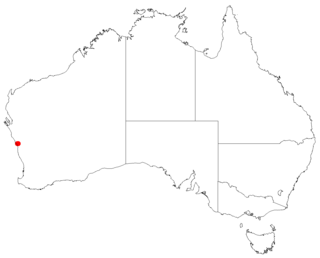
Leucopogon navicularis is a species of flowering plant in the heath family Ericaceae and is endemic to the southwest of Western Australia. It is an erect, compact shrub with hairy young branchlets, narrowly elliptic to narrowly egg-shaped leaves and erect, compact clusters of 4 to 12 white, bell-shaped flowers in upper leaf axils or on the ends of branches.

Leucopogon neoanglicus, commonly known as New England beard heath, is a species of flowering plant in the heath family Ericaceae and is endemic to eastern Australia. It is an erect shrub with egg-shaped leaves, sometimes with the narrower end towards the base, and white, tube-shaped flowers arranged singly in leaf axils and bearded inside.
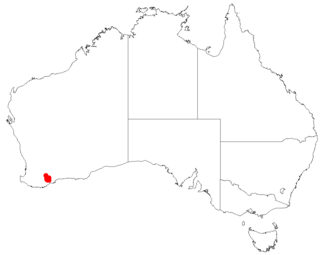
Leucopogon newbeyi is a species of flowering plant in the heath family Ericaceae and is endemic to a small area in the southwest of Western Australia. It is an erect shrub with densely hairy young branchlets, linear to narrowly elliptic or narrowly egg-shaped leaves and erect, compact clusters of 7 to 17 white, bell-shaped flowers mainly on the ends of branches.

Leucopogon pilifer, commonly known as thready beard-heath, is a species of flowering plant in the heath family Ericaceae and is endemic to south-eastern Australia. It is a low-lying, dwarf, often mat-forming shrub with long branches, oblong to lance-shaped leaves and crowded, white spikes of densely bearded flowers arranged in groups of between 4 and 9.

Leucopogon prolatus is a species of flowering plant in the heath family Ericaceae and is endemic to the south-west of Western Australia. It is an erect, open shrub with a single stem at ground level, egg-shaped to elliptic leaves and erect clusters of 3 to 14 white flowers on the ends of branches and short side-branches.
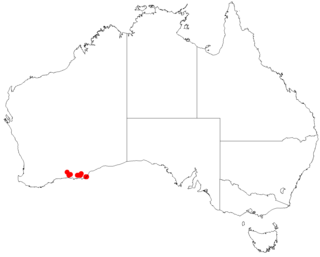
Leucopogon remotus is a species of flowering plant in the heath family Ericaceae and is endemic to the south-west of Western Australia. It is an erect shrub with a single stem at ground level, narrowly egg-shaped to egg-shaped leaves and erect clusters of 4 to 11 white, tube-shaped flowers usually on the ends of branches.

Leucopogon rodwayi is a species of flowering plant in the heath family Ericaceae and is endemic to coastal New South Wales. It is an erect to spreading shrub with narrowly egg-shaped to elliptic leaves, and pendent, white, tube-shaped flowers arranged in groups of 6 to 15 in leaf axils, forming a spike up to 8 mm (0.31 in) long.





















